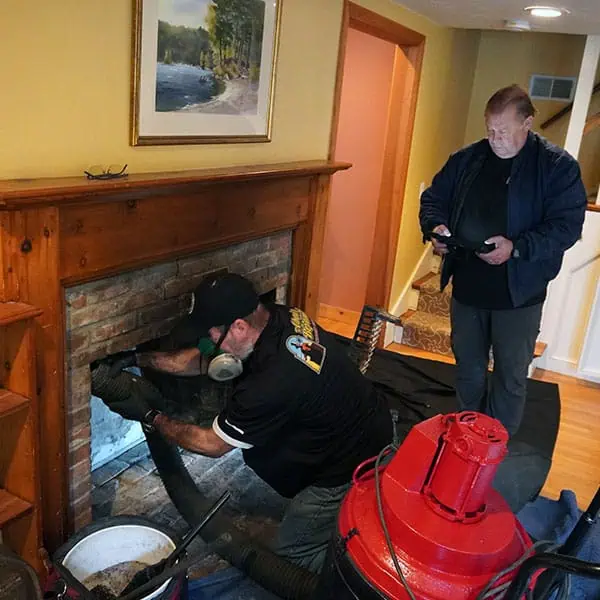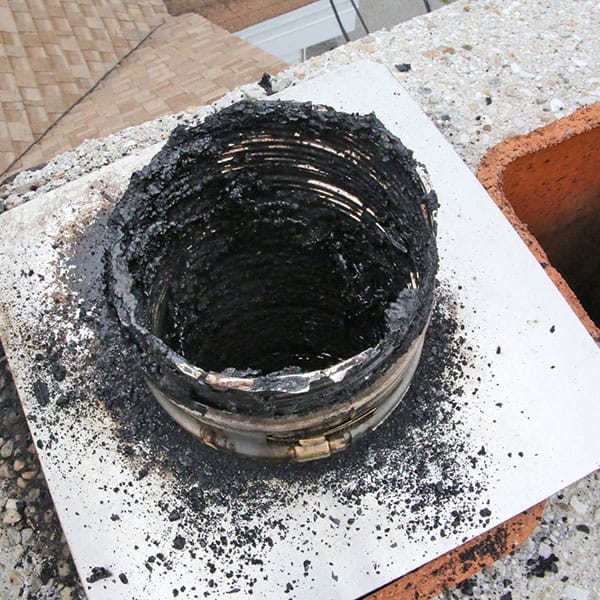Recognize the critical warning signs that your Providence County chimney needs immediate professional cleaning and maintenance.
Share:

The most obvious sign your chimney needs cleaning is what you can actually see. Black, powdery soot or shiny, tar-like creosote deposits around your fireplace opening or damper area are red flags you can’t ignore.
Soot appears as fine, dusty particles that can fall into your firebox or coat the walls inside your fireplace. Creosote, on the other hand, looks more like thick, sticky tar and poses a serious fire hazard. When creosote reaches just 1/8 inch thick, your risk of chimney fire increases dramatically.
If you notice either substance building up visibly, or if you can scrape off thick, black deposits with your finger, it’s time to schedule professional cleaning immediately.

Finding chunks of soot or debris in your fireplace after it’s been sitting unused is a clear indicator that buildup has reached dangerous levels. This happens when combustion deposits accumulate on the damper, smoke chamber, and flue liner, then begin to loosen and fall into the firebox.
This falling debris isn’t just messy—it’s a warning sign that your chimney system is compromised. The buildup restricts proper airflow and creates conditions where dangerous gases can’t escape safely from your home. You might also notice pieces of what looks like broken tile, which could be damaged flue liner from excessive creosote buildup.
Don’t try to clean this yourself or ignore it. Professional chimney sweeps have the tools and expertise to safely remove all buildup and assess any damage to your chimney structure. We’ll also check for underlying issues that caused the excessive accumulation in the first place.
The presence of falling soot often coincides with other warning signs like poor fire performance or unusual odors. When you see this debris, consider it your chimney’s way of saying it needs immediate professional attention to prevent more serious problems.
A properly maintained chimney shouldn’t produce unpleasant smells, especially when it’s not in use. If you notice strong, acrid odors coming from your fireplace—particularly during humid weather or summer months—creosote buildup is likely the culprit.
These odors become more pronounced when moisture mixes with the tar-like creosote deposits, creating a smell that many homeowners describe as similar to barbecue smoke or asphalt. The smell can become overwhelming during damp weather because humidity causes the creosote to release stronger vapors.
What makes this particularly concerning is that the same moisture causing the odors can also make creosote more corrosive to your chimney liner and masonry. Over time, this can lead to structural damage and expensive repairs. The acidic nature of wet creosote can eat away at metal components and deteriorate mortar joints.
You might also notice musty odors, which could indicate water intrusion or mold growth inside your chimney. This often happens when animal nests or debris block proper ventilation, creating conditions where moisture can’t escape. Either way, persistent odors from your fireplace are your home’s way of telling you that professional cleaning and inspection are overdue.
Don’t mask these smells with air fresheners or assume they’ll go away on their own. Professional cleaning removes the source of the odors and addresses the underlying buildup causing them.
Your fireplace should draw smoke up and out of your home efficiently. When it doesn’t, you’ll notice the difference immediately. Poor draft shows up as smoke entering your room instead of going up the chimney, difficulty getting fires started, or fires that won’t stay lit even with dry wood.
These issues often stem from blockages or buildup restricting the airflow your fireplace needs to function properly. A chimney requires specific airflow balance—enough air to fuel the fire and enough escaping air to vent harmful fumes and smoke safely.
When this balance is disrupted by creosote, soot, or debris, your fireplace becomes inefficient and potentially dangerous. Carbon monoxide and other toxic gases can back up into your living space instead of being safely vented outside.

If smoke billows into your room when you start a fire, stop using your fireplace immediately. This is one of the most serious warning signs that your chimney needs professional attention. Properly functioning chimneys create an upward draft that pulls smoke and gases out of your home, not into it.
When smoke comes back into your room, it indicates a significant blockage or ventilation problem. This could be caused by heavy creosote buildup, animal nests, debris, or structural issues with your chimney. The blockage prevents the natural draft from working correctly, forcing smoke to find another path—unfortunately, that path is often back into your home.
This situation poses immediate health risks. You’re breathing in harmful combustion byproducts that should be venting safely outside. Carbon monoxide, in particular, is colorless and odorless but can be deadly in enclosed spaces. Even short exposure to these gases can cause headaches, dizziness, and respiratory issues.
Don’t attempt to “burn out” the blockage or continue using your fireplace hoping the problem will resolve itself. This can make the situation worse and potentially start a chimney fire. Professional chimney sweeps have specialized equipment to safely identify and remove blockages while protecting your home and family.
The good news is that most draft problems are completely fixable with proper cleaning and maintenance. Once the obstruction is removed, your fireplace should return to safe, efficient operation.
Providence County’s wildlife sees your chimney as prime real estate—a protected, elevated space perfect for nesting. Unfortunately, what’s good for animals is dangerous for your family. Animal nests create serious blockages that prevent proper ventilation and pose significant fire hazards.
You’ll know you have unwanted chimney guests when you find twigs, leaves, grass, or other nesting materials in your fireplace. You might also hear scratching, chirping, or scuttling sounds coming from your chimney, especially during spring and early summer when many animals are building nests. Some homeowners discover the problem when they see birds or squirrels entering or leaving the top of their chimney.
Animal droppings in your firebox are another telltale sign, and these pose health risks beyond just being unpleasant. Many wild animals carry diseases, parasites, and bacteria that can be transmitted to humans through dried droppings that become airborne.
The nesting materials themselves are highly flammable and can ignite easily when you use your fireplace. Even if the animals have moved on, their nests remain a fire hazard until professionally removed. These materials also block the airflow your chimney needs to function safely, potentially causing carbon monoxide to back up into your home.
Never attempt to remove animal nests yourself. Some birds, like chimney swifts, are federally protected and cannot be removed during certain times of the year. Professional wildlife removal and chimney cleaning services know how to handle these situations safely and legally while ensuring your chimney is thoroughly cleaned and protected against future intrusions.
Recognizing these warning signs early can save you from dangerous situations and expensive repairs. Whether you’re dealing with visible soot buildup, strange odors, poor fire performance, or signs of animal activity, professional chimney cleaning is the safe, effective solution.
Don’t wait until small problems become major hazards. A certified chimney sweep can safely remove all buildup, clear blockages, and inspect your entire system for potential issues. We have the specialized tools and training to protect your home while ensuring your chimney operates safely and efficiently.
For Providence County homeowners, we provide comprehensive cleaning and inspection services that keep your family safe and your fireplace ready for cozy winter nights ahead.
Article details:
Share: